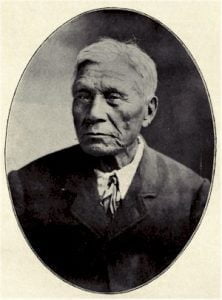The expeditions of Colonels Steptoe and Wright into the country of the Coeur d’Alenes, Spokane and Palouse were made without the blare of notoriety; they were not heralded by the press in startling headlines; nor were the minutiae of accompanying details flashed momentarily over convenient wires to an expectant nation. In obedience to orders laboriously conveyed to them, the commanders of these expeditions went forward to their duty. They went into a country to them unknown and pursued their courses under the direction of guides. On returning they bore the history of their achievements with them, save that which was impressed upon their adversaries. Excepting the few white men in charge of the Coeur d’Alene Mission, none of their race remained on the field of their operations to tell the coming settler of the things they did. And when in after years the settler arrived the physical evidences of combat had been almost obliterated. Meager and unauthenticated details of the story gained circulation among the early pioneers and were by them rehearsed from memory to those who came after them.
This volume, the result of long research, was primarily suggested through a lingering love of the pioneer days. The pleasures that were woven into the thin mesh of early day society and the occupations of those first citizens, as well as the hardships and privations which came into the country hand in ‘hand with the pioneer himself, are matters that have frequently passed in review of the writer’s memory. They are of a period which of itself constitutes an important epoch. From meditation upon these things has emanated the desire to place in the hands of the people the facts of the events which made it possible to settle and develop this great, rich section of country in unbroken peace of the time just beyond the real pioneer.
In the preparation of the work, the writer acknowledges grateful appreciation of the assistance of Mrs. Nannie Steptoe Eldridge, Lynchburg, Va., sister of Colonel E. J. Steptoe; Brig. Gen. David McMGregg (Lieutenant with Colonel Steptoe), Reading, Pa., who, besides offering valuable suggestions as to original sources of information, kindly gave the manuscript of the chapters covering Colonel Steptoe’s expedition a critical reading; Mrs. Mae D. Taylor Clark, Cincinnati, Ohio, daughter of Captain O. H. P. Taylor; Mrs. Bronson and Miss Mary G. Hawks, Summit, N. J., cousins of Lieutenant Wm. Gaston; H. N. Fleming, Erie, Pa., son of Major (Lieutenant with Colonel Steptoe) Hugh B. Fleming; Hugh Lyon, Crider, Ky., son of Brig. Gen. (Lieutenant with Colonel Wright) Hylan B. Lyon; Mrs. Edith Coventry, Henley-on-Thames, England, daughter of Colonel (Lieutenant with Colonel Wright) Lawrence Kip; Lieutenant Charles Braden, West Point, Secretary Association of Graduates, U. S. M. A.; Captain John Mullan, Washington, D. C.; General (Lieutenant with Colonel Wright) Michael R. Morgan, Minneapolis, Minn.; Hon. Wesley L. Jones, U. S. Senator, State of Washington, through whose assistance he was enabled to procure a large part of the official documents consulted and which have been extensively quoted; John O’Neill, J. J. Rohn and Thomas Beall, survivors of the Steptoe-Wright campaign whom he has personally consulted. He has also been kindly permitted to quote from the Journal of The Military Service Institution, Governor’s Island, N. Y., and has taken the liberty of quoting largely from Lieutenant Lawrence Kip’s valuable journal, “Army Life on the Pacific,” printed soon after Colonel Wright’s expedition, copies of which are now extremely difficult to find.

Coeur d’Alene
- Tradition of Steptoe Butte
- History of Steptoe Butte
- 1858, A Year of Hostile Indians
- Causes of Indian Grievances
- Indians Want Treaty Enforced
- Steptoe Marches North
- Palouse incite Coeur d’Alene and Spokane Indians
- Battle at Tohotonimme
- Council between the Officers
- Dragoon Soldiers Retreat
- Colonel Steptoe’s Report
- Casualty Report – Battle at Tohotonimme
- Section Map of Captain John Mullan
- Preliminaries before the Battle at Tohotonimme
- Treaty Of Peace and Friendship Between the United States and the Nez Perces Tribe
- Following Orders
- Measuring Strength with the Northern Indians
- Biographical
See Further
- Army Life on the Pacific, by Lawrence Kip
